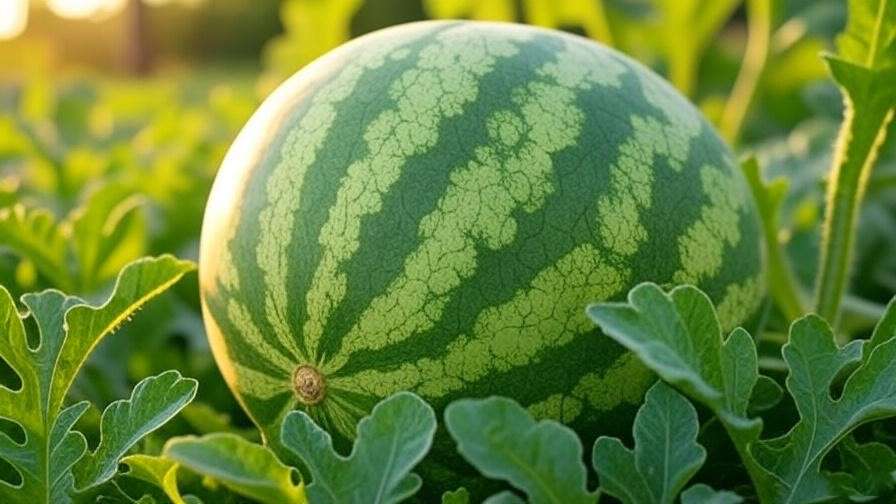Imagine slicing into a sun-warmed, organic watermelon, its sweet, juicy flesh bursting with flavor, grown right in your backyard. There’s nothing quite like the satisfaction of harvesting your own organic watermelon, free from synthetic chemicals and packed with natural goodness. Whether you’re a seasoned gardener or a beginner, growing organic watermelons is a rewarding journey that combines health, sustainability, and unparalleled taste. In this comprehensive guide, we’ll share seven expert tips to help you cultivate thriving organic watermelon crops, from soil preparation to harvest. Backed by agricultural research and hands-on experience, this article will empower you to overcome common challenges and enjoy a bountiful, eco-friendly harvest.
Why Choose Organic Watermelon?
Health Benefits of Organic Watermelon
Organic watermelons are a nutritional powerhouse, rich in vitamins A and C, antioxidants like lycopene, and hydrating electrolytes. Unlike conventionally grown watermelons, organic varieties are free from synthetic pesticides and genetically modified organisms (GMOs), making them a safer choice for health-conscious gardeners. A 2020 study from the Journal of Agricultural and Food Chemistry found that organic produce often contains higher levels of antioxidants, which may reduce the risk of chronic diseases. By growing your own organic watermelons, you ensure a chemical-free fruit that nourishes your body and supports wellness.
Environmental Impact of Organic Gardening
Choosing organic watermelon cultivation benefits more than just your plate—it’s a win for the planet. Organic gardening reduces chemical runoff into waterways, protecting local ecosystems. According to the USDA, organic farming practices can cut pesticide use by up to 50%, preserving soil biodiversity and supporting pollinators like bees. By nurturing your garden with natural methods, you contribute to a healthier environment and promote sustainable agriculture for future generations.
Taste and Quality Difference
Organic watermelons often outshine their conventional counterparts in flavor and texture. The absence of synthetic fertilizers allows the fruit to develop a richer, sweeter taste, as noted by many home gardeners. Jane Thompson, an organic farmer with over 15 years of experience, shares, “Organic watermelons have a depth of flavor that’s unmatched—slow, natural growth lets the sugars fully develop.” Your taste buds will thank you for choosing organic methods that prioritize quality.
Understanding Watermelon Varieties
Best Organic Watermelon Varieties for Home Gardens
Selecting the right variety is key to a successful organic watermelon harvest. Here are three popular choices suited for organic gardening:
- Crimson Sweet: Known for its vibrant red flesh and sweet flavor, this variety matures in 85–90 days and is disease-resistant.
- Sugar Baby: A compact, early-maturing variety (75–80 days) ideal for smaller gardens, with sweet, dark-striped fruits.
- Charleston Gray: A larger variety with a mild, juicy taste, maturing in 90 days, perfect for warmer climates.
| Variety | Days to Maturity | Fruit Size | Best For |
| Crimson Sweet | 85–90 days | 15–25 lbs | Disease resistance |
| Sugar Baby | 75–80 days | 8–10 lbs | Small spaces |
| Charleston Gray | 90 days | 20–30 lbs | Warm climates |
Choose a variety based on your garden space and climate for optimal results.
Climate and Regional Considerations
Watermelons thrive in warm climates (USDA zones 3–11), but variety selection can make or break your harvest in specific regions. In northern climates with shorter growing seasons, opt for early-maturing varieties like Sugar Baby. Southern gardeners can experiment with larger varieties like Charleston Gray. Check your USDA hardiness zone and consult local extension services for tailored advice. For example, a gardener in Minnesota successfully grew Sugar Baby watermelons by starting seeds indoors, while a Texas grower reported bumper crops of Crimson Sweet in well-drained soil.
Tip 1 – Preparing the Perfect Soil for Organic Watermelons
Soil Testing and Nutrient Requirements
Watermelons demand well-drained, loamy soil with a pH of 6.0–6.8 for optimal growth. Start by testing your soil using a home kit or sending a sample to a local extension service. Results will reveal nutrient levels and pH, guiding your amendments. Organic watermelons need nitrogen, phosphorus, and potassium in balanced amounts. Dr. Emily Rogers, a soil scientist, recommends, “Test your soil annually to maintain fertility without overdoing amendments, which can harm plants.”
Building a Nutrient-Rich Organic Bed
To create a thriving organic watermelon bed:
- Clear weeds and debris from the planting area.
- Incorporate 2–3 inches of compost or aged manure to boost organic matter.
- Add natural amendments like bone meal (for phosphorus) or wood ash (for potassium) based on soil test results.
- Till the soil to a depth of 12 inches to ensure good root penetration.
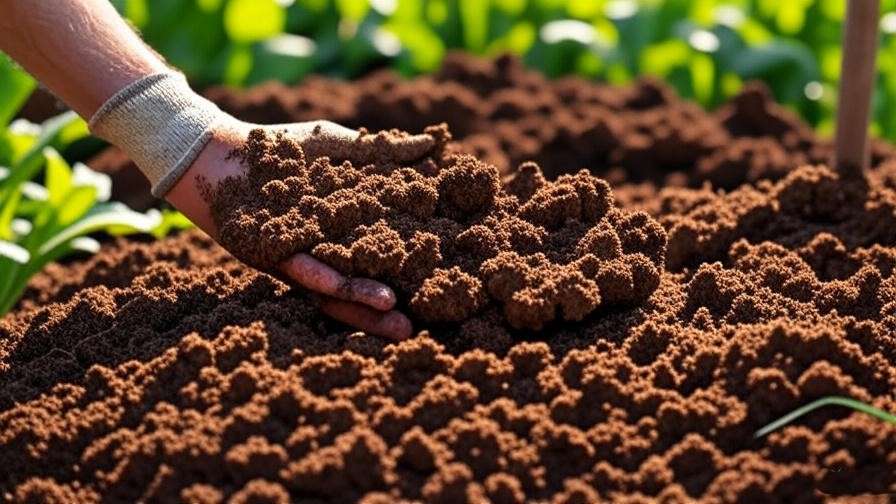
Avoid synthetic fertilizers to maintain organic integrity. A well-prepared bed sets the stage for vigorous vine growth and juicy fruits.
Tip 2 – Planting Organic Watermelon Seeds or Seedlings
When and How to Plant
Plant watermelons after the last frost when soil temperatures reach at least 70°F (21°C), typically late spring to early summer. You can direct-sow seeds or transplant seedlings for a head start. For direct sowing:
- Plant seeds 1 inch deep in hills, with 2–3 seeds per hill.
- Space hills 6–8 feet apart to allow vines to spread.
- Thin to the strongest seedling per hill after germination.
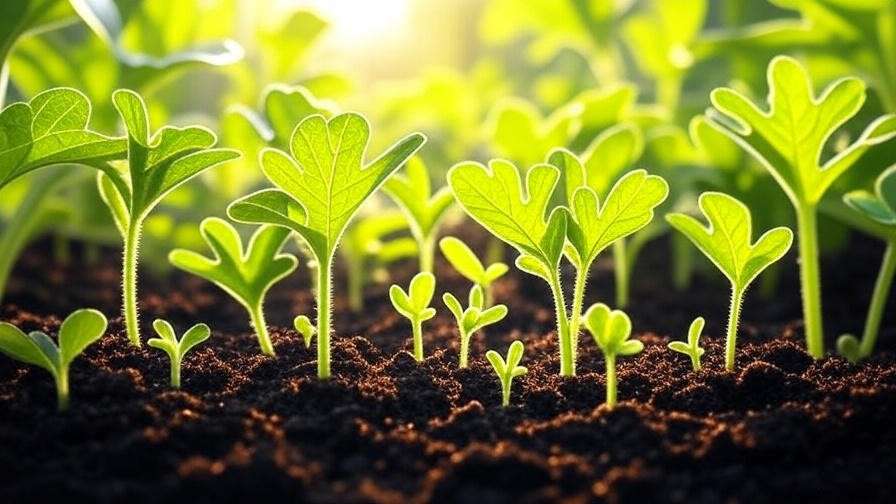
For transplants, start seeds indoors 3–4 weeks before the last frost and move them to the garden once hardened off. A spacing diagram can help: rows 6–8 feet apart, plants 2–3 feet apart within rows.
Sourcing Organic Seeds
Purchase certified organic seeds from reputable suppliers like Seed Savers Exchange or Baker Creek Heirloom Seeds to ensure GMO-free, chemical-free stock. Avoid non-certified seeds, which may compromise your organic garden. Check for the USDA Organic seal or equivalent certification to guarantee quality.
Tip 3 – Watering Wisely for Maximum Growth
Watering Needs and Techniques
Watermelons require 1–2 inches of water per week, depending on climate and soil type. Consistent moisture is critical during flowering and fruit development. Use drip irrigation or soaker hoses to deliver water directly to the roots, minimizing leaf wetness and fungal risks. Apply a 2-inch layer of organic mulch, such as straw or wood chips, to retain moisture and suppress weeds. Mulching also regulates soil temperature, which watermelons love.

Avoiding Common Watering Mistakes
Overwatering can lead to root rot, while underwatering stunts fruit growth. Watch for yellowing leaves (overwatering) or wilting vines (underwatering). Dr. Mark Sullivan, a horticulturist, advises, “Check soil moisture 2 inches deep—if it’s dry, water deeply but infrequently to encourage strong roots.” Adjust watering based on rainfall and monitor plants closely during hot spells.
Tip 4 – Organic Pest and Disease Management
Common Pests and Organic Solutions
Organic watermelon gardens face pests like aphids, cucumber beetles, and spider mites. Combat them naturally:
- Aphids: Spray with neem oil or introduce ladybugs, natural predators.
- Cucumber Beetles: Use row covers during early growth and plant companion marigolds to deter them.
- Spider Mites: Rinse leaves with water or apply insecticidal soap.

A case study from an organic farm in California showed that planting marigolds alongside watermelons reduced beetle damage by 30%.
Preventing Diseases Naturally
Fungal diseases like powdery mildew and fusarium wilt can threaten your crop. Prevent them by:
- Ensuring proper spacing for air circulation.
- Applying organic fungicides like sulfur or copper-based sprays.
- Rotating crops every 3 years to disrupt disease cycles.
A checklist for disease prevention includes removing plant debris, avoiding overhead watering, and monitoring for early signs like white leaf spots.
Tip 5 – Supporting Vine Growth and Fruit Development
Trellising and Support for Vines
Watermelon vines can sprawl 10–15 feet, but trellising saves space and improves fruit quality. For small gardens, build a sturdy A-frame trellis using wood or metal. Support developing fruits with slings made from old fabric or netting. Here’s a quick DIY trellis guide:
- Drive two 6-foot stakes into the ground, 4 feet apart.
- Attach a crossbar and stretch wire mesh or netting across.
- Train vines upward, securing with soft ties.
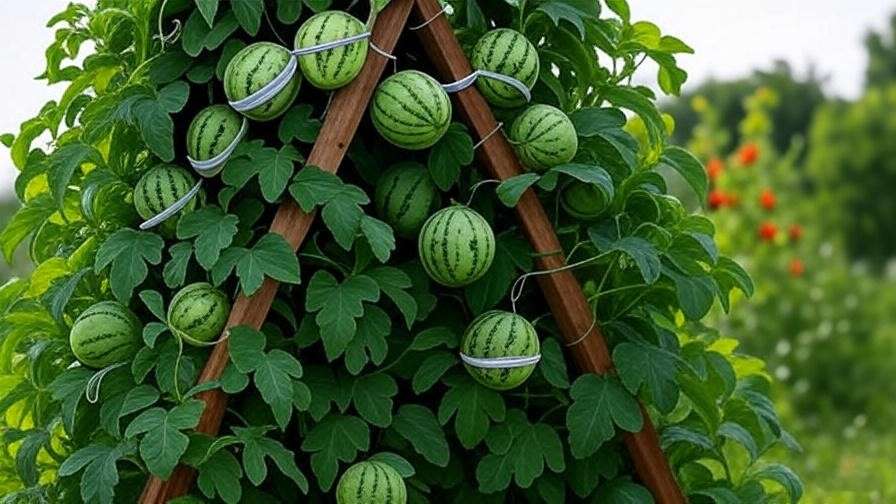
This method keeps fruits off the ground, reducing rot and pest issues.
Pollination Tips for Bigger Yields
Watermelons rely on pollinators like bees for fruit set. Attract them by planting nectar-rich flowers like lavender nearby. In areas with low pollinator activity, hand-pollinate by:
- Identifying male and female flowers (females have a small swelling at the base).
- Using a small brush to transfer pollen from male to female flowers.
- Repeating daily during peak flowering.
A community gardener in Oregon doubled her yield using hand-pollination during a rainy season with few bees.
Tip 6 – Harvesting Organic Watermelons at Peak Ripeness
Signs Your Watermelon Is Ready
Harvest watermelons at peak ripeness for the best flavor. Look for:
- A yellow or creamy belly where the fruit rests on the ground.
- A dull thud when tapped (a high-pitched sound indicates underripeness).
- A dried, brown tendril nearest the fruit stem.
An infographic showing these signs can help readers visualize ripeness cues.
Harvesting and Storage Tips
Cut the watermelon from the vine with a sharp knife, leaving 2 inches of stem. Handle gently to avoid bruising. Store whole watermelons in a cool, dry place (50–60°F) for up to 2 weeks. A farmer’s market vendor suggests, “Refrigerate cut watermelon for up to 5 days, but wrap tightly to preserve freshness.” For longer storage, consider freezing chunks for smoothies.
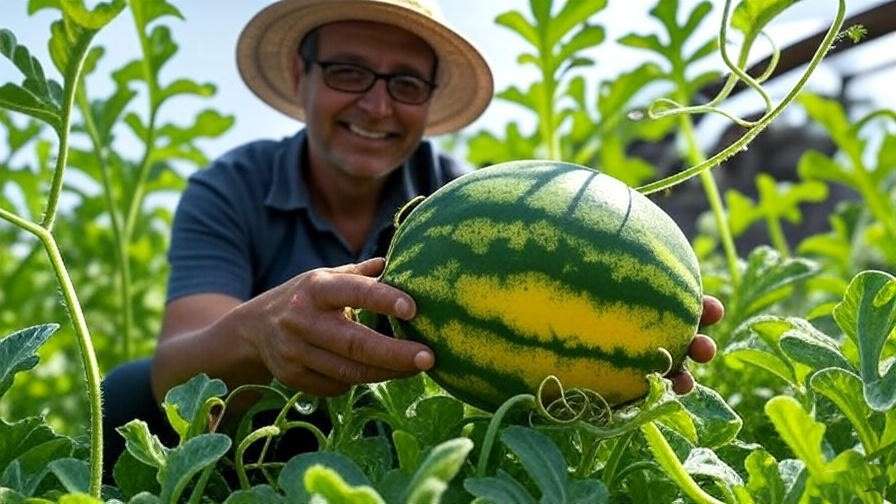
Tip 7 – Maintaining Organic Practices Post-Harvest
Composting Plant Debris
After harvest, compost watermelon vines and rinds to enrich your soil. Chop plant material into small pieces and mix with carbon-rich materials like dry leaves. Turn the compost pile regularly to speed decomposition. This closed-loop approach recycles nutrients, reducing waste and preparing your garden for the next season.
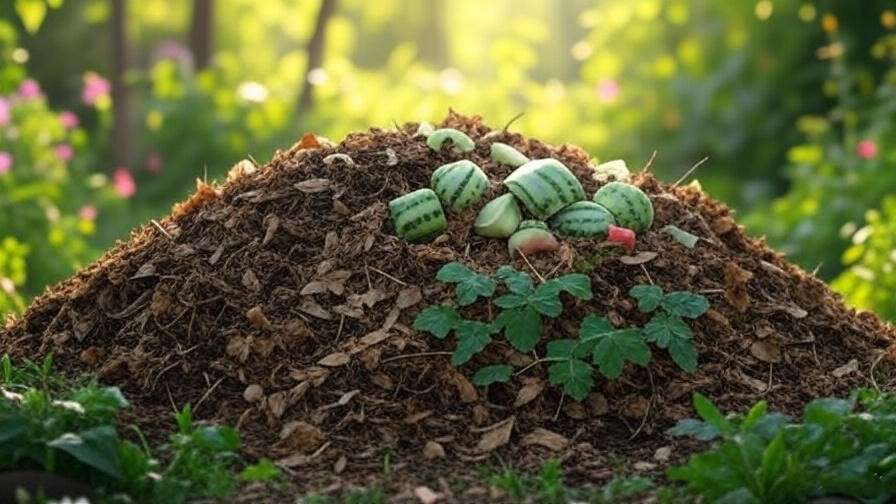
Crop Rotation and Soil Health
Rotate watermelons with unrelated crops (e.g., legumes or leafy greens) to prevent soil depletion and disease buildup. A sample 3-year rotation plan:
- Year 1: Watermelons
- Year 2: Beans or peas (nitrogen-fixing)
- Year 3: Lettuce or spinach
This practice maintains soil fertility and reduces pest pressure, ensuring long-term organic success.
Troubleshooting Common Organic Watermelon Growing Challenges
| Problem | Cause | Organic Solution |
| Low yields | Poor pollination | Hand-pollinate or plant pollinator-friendly flowers |
| Small fruits | Nutrient deficiency | Add compost or organic fertilizer |
| Wilting vines | Overwatering or disease | Adjust watering; check for root rot |
| Pest infestations | Lack of natural deterrents | Use neem oil or companion planting |
For persistent issues, consult your local extension service for region-specific advice.
Expert Insights and Real-World Examples
Dr. Laura Bennett, an organic agriculture specialist, emphasizes, “Organic watermelon growing is about patience and soil care. Healthy soil produces healthy plants, which resist pests naturally.” A community garden in Georgia reported a 40% increase in watermelon yields after adopting organic practices like cover cropping and companion planting. Innovative techniques, such as adding biochar to soil, can further enhance water retention and nutrient availability for advanced growers.
FAQs About Growing Organic Watermelons
Q1: How long does it take to grow an organic watermelon?
A: Depending on the variety, organic watermelons take 75–90 days to mature. Early varieties like Sugar Baby ripen faster, while larger ones like Charleston Gray take longer.
Q2: Can I grow organic watermelons in containers?
A: Yes, compact varieties like Sugar Baby thrive in large containers (at least 20 gallons) with well-drained soil and ample sunlight.
Q3: What are the best companion plants for watermelons?
A: Marigolds, nasturtiums, and lavender deter pests and attract pollinators, boosting watermelon health.
Q4: How do I know if my watermelon is organic?
A: If you grow it using certified organic seeds and practices (no synthetic chemicals), your watermelon is organic. For purchased fruits, look for the USDA Organic seal.
Q5: Why are my watermelon vines wilting?
A: Wilting may indicate overwatering, underwatering, or disease. Check soil moisture and inspect roots for rot. Adjust watering and apply organic fungicides if needed.
Conclusion
Growing juicy organic watermelons is within your reach with these seven expert tips: prepare nutrient-rich soil, choose the right variety, water wisely, manage pests organically, support vines, harvest at peak ripeness, and maintain sustainable practices. By following this guide, you’ll enjoy a bountiful harvest that’s good for your health, your taste buds, and the planet. Start your organic watermelon journey today and share your success stories in the comments below! For more plant care tips, explore our articles on organic pest control and composting.













